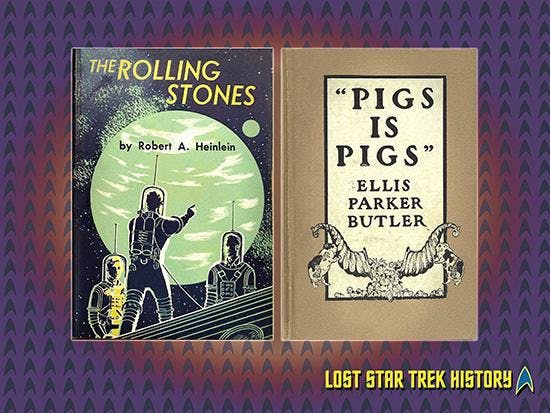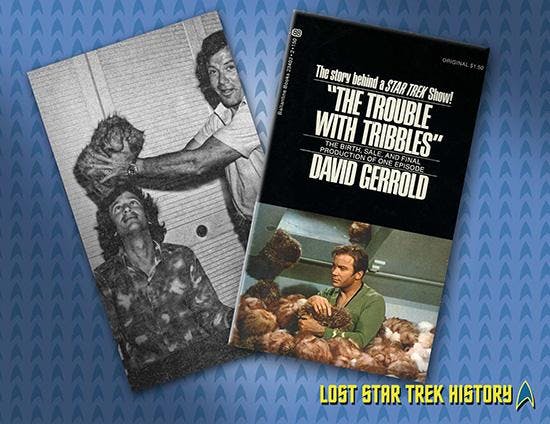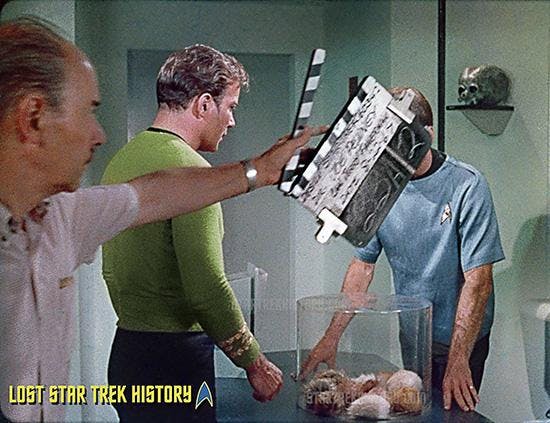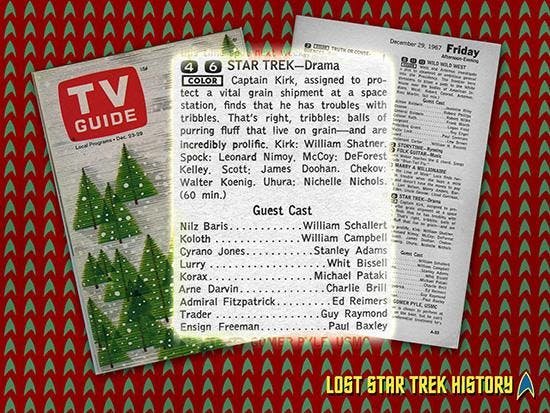Published Dec 28, 2019
Celebrating 52 Years of "The Trouble with Tribbles"
What on Earth was a "fuzzie"?

StarTrek.com
“The Trouble With Tribbles,” written by David Gerrold, is one of the very best episodes of Star Trek: The Original Series. Although it’s different from other, more-serious TOS episodes, “The Trouble With Tribbles” is perfectly at home with them because it shines with an element that’s also an important Star Trek staple: great comedy. After all, who hasn’t chuckled at Scotty’s reply to Kirk when he finally tells him why he threw the first punch at the Klingons? Or to Mr. Spock’s dry announcement to his captain concerning how many Tribbles likely were in the grain compartment as they were falling on his head?
Since today is the 52nd anniversary of the first broadcast of “The Trouble With Tribbles,” we thought we’d take a look at the development of the episode from its initial story premise to the final product. However, since a detailed examination would require more discussion than we have space for, we’ll just skim the surface or, in other words… we’ll just sample one of everything at the buffet.
Story Premise
“The Trouble With Tribbles” started as a premise called “The Fuzzies,” one of five that Gerrold submitted to Star Trek in February, 1967. As the title implies, Tribbles were initially named fuzzies, and the plot elements in the story were somewhat different from those that ended up in “The Trouble With Tribbles.”

“The Fuzzies” told the tale of Kirk protecting a warehouse of grain at a trading post on the planet Barth, a peaceful planet with a frontier culture similar to 1870’s Earth. The grain itself was owned by a company under the direction of Damon Jones, and a competing company on the planet, the Barth Corporation (selling neo-corn), was very jealous.
Kirk’s mission started fairly uneventfully, but it quickly was upended when Cyrano Smith, a planet locator who was a conman, arrived at the trading post with his small, furry fuzzies. Similar to what happened in the finished episode, Smith sold his fuzzies to various shopkeepers, and when one was brought on board the Enterprise — by Janice Rand in Gerrold’s premise — it produced “pups” that continued to breed until the crew was hip-deep in them. In fact, there were so many around that the cook told Kirk that they were even in the flour stores on the ship.
Wait. Flour? Can’t you make flour from grain? Ah-ha!
When the cook mentioned to Kirk and Spock that the fuzzies had gotten into the flour, they suddenly realized that the fuzzies may have gotten into the grain in the warehouse on Barth… so they immediately beamed to the planet and confirmed that they not only had gotten into it but they had also consumed it. Shockingly, they also found that the fuzzies that had eaten it were dead.
Searching for answers to the mystery of the fuzzies, their deaths, and the grain, Kirk tracked down Smith — who had fled the planet — and he confessed to knowing that the fuzzies bred fast when fed; however, he knew nothing about the grain on the planet. Shortly thereafter, Kirk learned that the fuzzies were killed by a poison in the grain and, with the help of Smith, he was able to finger Damon Jones' assistant – a covert employee of the Barth Corporation – as the one who masterminded the poisoning. With all the major plot points now wrapped up, the treatment ended with a new shipment of grain en route to Barth, Smith remaining on the planet to catch all the fuzzies, and Janice Rand sporting a new pair of fluff-ball earrings — which Kirk initially mistook as fuzzies — in what was hoped to be a humorous tag.

Story Outline
After receiving feedback about the premise from the production company (mainly from producer Gene Coon), Gerrold wrote an outline entitled “A Fuzzy Thing Happened To Me…” that was turned in on June 17, 1967. At 35 pages, it was one of the longer outlines for a TOS episode, mainly because Gerrold included a substantial amount of dialogue – a lot of which survived to the broadcast version. This outline had all the major parts contained within the final episode with only a few major differences:
- Deep Space Station K7 was called "Topsy"ft and it was comprised of randomly joined modules
- The Enterprise was on its way to Topsy for a variety of reasons, including picking up the mail for the crew
- Sherman’s planet is named Barger’s planet
- Sulu accompanies Uhura to the space station, not Chekov, and he’s interested in the quadro-triticale because he’s a botanist
- Cyrano Jones is Cyrano Day Jaymin in the outline and he’s a planetary scout (locator)
- The Tribbles are called fuzzies
- Cyrano, not a Tribble, is the one who reveals that Arne Darvin is a Klingon spy
- Scott's famous line “Where they’ll be no Tribble at all” is not present at the end
First Draft Script
Gerrold received comments and critiques on the outline from the production company and then went to work writing a first draft. Ultimately, one was completed on July 21, 1967. Overall, the first draft is quite close to what finally ended up in the shooting draft (the revised final draft) and on the screen except for:
- The teaser neither takes place in the briefing room nor contains Chekov and Spock’s “extremely little” joke. Rather, the teaser takes place on the bridge and involves a discussion of the disputed nature of Sherman’s planet
- Sulu has Chekov’s part in Act I
- Some proper names are different. For example, Korax compares Kirk to a Sirian Blood Worm instead of a Regulan Blood Worm
- Kirk asks Ensign Freeman, a part Gerrold wrote for himself, to have someone gather up the Tribbles on the Enterprise
- Cyrano Jones leaves deep space station K7 on his ship after Kirk finds the Tribbles in the grain compartment. Kirk has to chase him down
- Lurry is the person who recognizes that the Tribbles that ate the grain in the warehouse are dying
- Scott's famous line “Where they’ll be no Tribble at all” is not present at the end. Instead, Kirk expresses his surprise at the Tribble solution and suggests that he might give Scott a raise for it.

Revised Final Draft Script and Shooting
Since the first draft script for the episode was close to being shootable, the final changes dictated by the producers were relatively minor, so they were quick and easy to make. Thus, the revised final draft script was completed on August 1, 1967 (some minor revisions were made later, out to August 21) and principal photography was done from August 22 until August 29. The script was essentially shot as written, and most of it wound up in the broadcast version. (To see some material that was not included in the final episode, check out the Roddenberry Vault Blu-ray discs that were released in 2016 by CBS Home Entertainment and Roddenberry Entertainment.)
Publicity
Unlike many other episodes of TOS, there wasn’t much publicity for “The Trouble With Tribbles” when it was released. For whatever reason, Desilu and the NBC network didn’t hire still photographers to take pictures of the guest stars — either the Tribbles or the actors playing the guest roles — and they didn’t send out any significant advance publicity information. Advertising appears to have been limited to the simple storyline released to the media by Desilu’s public relations company.

David Tilotta is a professor at North Carolina State University in Raleigh, NC and works in the areas of chemistry and sustainable materials technology. You can email David at david.tilotta@frontier.com. Curt McAloney is an accomplished graphic artist with extensive experience in multimedia, Internet and print design. He resides in a suburb of the Twin Cities in Minnesota, and can be contacted at curt@curtsmedia.com. Together, Curt and David work on startrekhistory.com. Their Star Trek work has appeared in the Star Trek Magazine and Star Trek: The Original Series 365 by Paula M. Block with Terry J. Edrmann.

